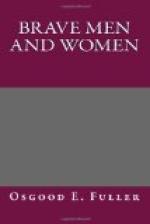* * * * *
Conclusion,
True worker with
the Lord,
He labors not
for hire;
Co-partner in the sure reward,
What can he more
desire?
Sometimes his
eyes are dim,
All signs he can
not spell;
Yet he endures as seeing Him
Who is invisible.
The work he ought
is bliss,
The highest thing
to crave;
And all his life is found
in this
Memorial for his
grave:
A worker with
the Lord,
He sought no
other name,
And found therein enough
reward,
Enough, enough
of fame.
* * * * *
XLVI.
ALVIN S. SOUTHWORTH
CROSSING THE NUBIAN DESERT.
This gentleman, a member of the American Geographical Society, has furnished, in the columns of The Sunday Magazine, the following picture of his experience in crossing the most perilous of the African deserts:
Those who have not actually undergone the hardships of African travel almost always believe that the most dangerous desert routes are found in the Great Sahara. Such is not the fact. The currency given to this popular delusion is doubtless due to the immensity of the arid waste extending from the Mediterranean to the Soudan, and which is deceptive in its imagined dangers because of its large area. All travelers who have made the transit of the Nubian Desert from Korosko, situated between the First and Second Cataracts, southward across the burning sands of the Nubian Desert, a distance of 425 miles, concur in the statement that it is an undertaking unmatched in its severity and rigors by any like journey over the treeless and shrub-less spaces of the earth. “The Flight of a Tartar Tribe,” as told by De Quincey, in his matchless descriptive style, carrying his readers with him through scenes of almost unparalleled warfare, privation, and cruelty, until the remnant of the Asiatic band stands beneath the shadow of the Chinese Wall to receive the welcome of their deliverer, but imperfectly portrays the physical suffering that must be endured in the solitude of the most dangerous of African deserts. Let me, therefore, briefly record my life in the Nubian Desert, at a time when I was filled with the hopes and ambitions which led Bruce, in the last century, to the fountains of the Blue Nile, and but a few years since guided Speke and Grant, Sir Samuel Baker, and Stanley to the great basin of the major river, and determined the general geography of the equatorial regions.




